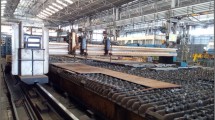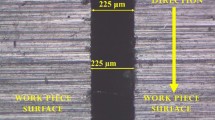Abstract
Saw blades are one of the most used cutting tools. They compose the expensive parts of a cutting machine. Therefore, saw-blade wear is an important parameter governing the economy of the cutting process. Significant savings could be made when it is controlled effectively. In this study, a new methodology is employed for the determination of the saw-blade wear in the cutting of two types of marble. Wear of segments is determined by high-precision inductively coupled plasma method. Two types of marbles were used to investigate the wear performance of diamond-impregnated segments of circular saw-blade matrix. Taguchi mixed design L16 (43 21) is used as an experimental design and the results are evaluated statistically with Minitab. The results reveal that the specific wear rate (SWR) of Beige marble increases with the increase of the peripheral speed, traverse speed, depth of cut and down-cut mode operation. Additionally, it is demonstrated that the traverse speed and peripheral speed are the dominant cutting parameters affecting the SWR. It is also seen that similar trends are observed for Onyx marble (excluding peripheral speed). Finally, it is concluded that the proposed models can be effectively used for the estimation of the SWR.




Similar content being viewed by others
References
Montani C 2016 XXVII World Marble and Stones Report. Carrara: Aldus
Yurdakul M 2015 Effect of cutting parameters on consumed power in industrial granite cutting processes performed with the multi-disc block cutter. Int. J. Rock Mech. Min. Sci. 76: 104–111
Aydin G, Karakurt I and Aydiner K 2013 Development of predictive models for the specific energy of circular diamond saw blades in the sawing of granitic rocks. Rock Mech. Rock Eng. 46: 767–783
Aslantas K, Özbek O, Ucun I and Buyuksagis I S 2009 Investigation of the effect of axial cutting force on circular diamond saw blade used in marble cutting process. Mater. Manuf. Processes 24: 1423–1430
Atıcı U and Ersoy A 2009 Correlation of specific energy of cutting saws and drilling bits with rock brittleness and destruction energy. J. Mater. Process. Technol. 209: 2602–2612
Ersoy A and Atıcı U 2004 Performance characteristics of circular diamond saws in cutting different types of rocks. Diam. Relat. Mater. 13: 22–37
Li Y, Huang H, Shen J Y, Xu X P and Gao Y S 2002 Cost-effective machining of granite by reducing tribological interactions. J. Mater. Process. Technol. 129: 389–394
Yilmaz N G 2016 Size analysis of the chips generated during abrasive machining of granite in relation to productivity and efficiency parameters. Particul. Sci. Technol. 34: 593–601
Goktan R M and Yilmaz N G 2017 Diamond tool specific wear rate assessment in granite machining by means of Knoop micro-hardness and process parameters. Rock Mech. Rock Eng. 50: 2327–2343
Aydin G, Karakurt I and Hamzacebi C 2015 Performance prediction of diamond saw blades using artificial neural network and regression analysis. Arab. J. Sci. Eng. 40: 2003–2012
Tumac D 2015 Predicting the performance of large diameter circular saws based on Schmidt hammer and other properties for some Turkish carbonate rocks. Int. J. Rock Mech. Min. Sci. 75: 159–168
Tumac D 2016 Artificial neural network application to predict the sawability performance of large diameter circular saws. Measurement 80: 12–20
Aydin G, Karakurt I and Aydiner K 2013 Wear performance of saw blades in processing of granitic rocks and development of models for wear estimation. Rock Mech. Rock Eng. 46: 1559–1575
Yılmaz N G 2013 Process efficiency comparison of a sandwich-core saw blade and a conventional saw blade used in stone-machining. J. Clean Prod. 47: 26–31
Ataei M, Mikaeil R, Hoseinie S H and Hosseini S M 2012 Fuzzy analytical hierarchy process approach for ranking the sawability of carbonate rock. Int. J. Rock Mech. Min. Sci. 50: 83–93
Mikaeil R, Haghshenas S S, Haghshenas S S and Ataei M 2016 Performance prediction of circular saw machine using imperialist competitive algorithm and fuzzy clustering technique. Neural Comput. Appl. 29: 283–292
Bayram F 2013 Prediction of sawing performance based on index properties of rocks. Arab. J. Geosci. 6: 4357–4362
Alber M 2008 Stress dependency of the Cerchar abrasivity index (CAI) and its effects on wear of selected rock cutting tools. Tunnel. Undergr. Space Technol. 23: 351–359
Tönshoff H K, Hilmann-Apmann H and Asche J 2002 Diamond tools in stone and civil engineering industry: cutting principles, wear and applications. Diam. Relat. Mater. 11: 736–741
Rosa L G, Amaral P M, Anjinho C A and Fernandes J C 2004 Evaluation of diamond tool behaviour for cutting stone materials. Ind. Diam. Rev. 1: 46–50
Bayram F, Yasitli N E, Kulaksiz S and Ozcelik Y 2012 Optimization of limestone sawing using circular saws with reference to unit wear and energy. Proc. Inst. Mech. Eng. C: J. Mech. Eng. Sci. 227: 1069–1079
Büttner A 1974 Diamond tools and stone. Ind. Diam. Rev. 34: 89–93
Luo S Y and Liao Y S 1995 Study of behaviour of diamond saw-blades in stone processing. J. Mater. Process. Technol. 51: 296–308
Ilio A D and Togna A 2003 A theoretical wear model for diamond tools in stone cutting. Int. J. Mach. Tool Manuf. 43: 1171–1177
Ersoy A, Buyuksagic S and Atici U 2004 Wear characteristics of circular diamond saws in the cutting of different hard abrasive rocks. Wear. 258: 1422–1436
Buyuksagis I S 2007 Effect of cutting mode on the sawability of granites using segmented circular diamond saw blade. J. Mater. Process. Technol. 183: 399–406
Yılmaz N G 2011 Abrasivity assessment of granitic building stones in relation to diamond tool wear rate using mineralogy-based rock hardness indexes. Rock Mech. Rock Eng. 44: 725–733
Yılmaz N G, Goktan R M and Kibici Y 2011 An investigation of the petrographic and physicomechanical properties of true granites influencing diamond tool wear performance, and development of a new wear index. Wear 271: 960–969
Amaral P M, Fernandes J C and Rosa L G 2009 Wear mechanisms in materials with granitic textures—applicability of a lateral crack system model. Wear 266: 753–764
Ucun I and Buyuksagis I S 2009 Using of laser measurement system in determination of diamond segment wear. In: Proceedings of the 5th International Advanced Technology Symposium, Karabuk, Turkey, pp. 1553–1556 (in Turkish)
Roy R K 2001 Design of experiments using the Taguchi approach: 16 steps to product and process improvement. New York: Wiley-Inter science
Ucun I, Gokce B, Eken M S, Aslantas K, Buyuksagis I S and Tasgetiren S 2015 Determination of optimum cutting parameters in sawing process using diamond cutting disc by Taguchi method. AKU J. Sci. Eng. 15: 6–16 (in Turkish)
Montgomery D C 2001 Design and analysis of experiments. New York: Wiley
Liao Y S and Luo S Y 1992 Wear characteristics of sintered diamond composite during circular sawing. Wear 157: 325–337
Ertingshausen W 1985 Wear processes in sawing hard stone. Ind. Diam. Rev. 5: 254–258
Karakus A 2007 Investigation of optimum stripe sawing conditions for some marble units and relations with rock properties. Ph.D. Thesis, Cumhuriyet University, Sivas, (in Turkish)
Konstanty J 2002 Theoretical analysis of stone sawing with diamond. J. Mater. Process. Technol. 123: 146–154
Tönshoff H K and Warnecke G 1982 Research on stone sawing. Daniel P (Ed.) Advances in ultrahard materials application technology. Hornbeam, London, England: De Beers Industrial Diamond Division, vol. 1, pp. 36–49
Author information
Authors and Affiliations
Corresponding author
Rights and permissions
About this article
Cite this article
INAL, S., ERKAN, I. & AYDINER, K. Determination of the wear performance of diamond saw blades using inductively coupled plasma. Sādhanā 44, 127 (2019). https://doi.org/10.1007/s12046-019-1080-6
Received:
Revised:
Accepted:
Published:
DOI: https://doi.org/10.1007/s12046-019-1080-6




